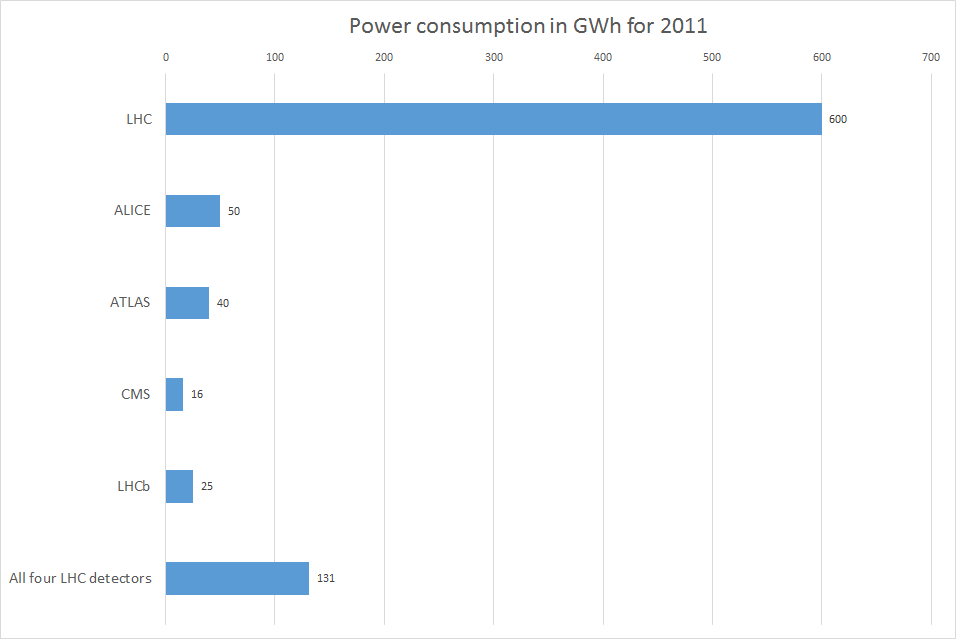
At the time when the minds of a few physicists are occupied with the design of a new detector, and the first meetings take place around a coffee table with detector engineers, the subjects discussed the most are the intensity and homogeneity of the magnetic field, the hermetic nature of the calorimeters, the material budget for the tracker, the integration and assembly scenario and so on. At least in the first drafts and sketches, the energy bill of the future detector receives comparatively little attention. But once the conceptual design is complete, and the detector is going to be built, the total power needs come to the fore. Electricity has to be available on site, possibly from two or more networks to assure the continuity in case of outages, while the cooling capacity has to cope with the power dissipated. Clearly, the energy consumed by the detector during operation has a cost, in terms of both money and environmental impact.
Comparison among four LHC experiments
The yearly power consumption of LHC and its experiments is recorded by CERN’s Engineering Department (see references below) and it is interesting to compare the data from 2011 (the last made available) to identify which experiment has the largest power consumption among the four. At the top of our ranking we have ALICE, with about 50 GWh[1], followed by ATLAS (40 GWh), LHCb (25 GWh) and finally CMS (only 16 GWh).
Looking at the details more carefully, we can easily understand the reasons for this ranking. ALICE’s magnet, dating from the ’80s and which formerly belonged to the L3 experiment at LEP, is a very large, low-field, resistive (i.e. non-superconducting) solenoid. This magnet, combined with the additional dipole, also resistive, consumes a lot of power and is responsible for 95% of the overall detector consumption. LHCb’s magnet – a dipole – is also resistive, therefore requiring a lot of power to run. Although ATLAS has only superconductive magnets (three toroids plus a small solenoid), its relatively high power consumption is essentially due to its complex cryogenic system, which is necessary to keep cold not only the magnets but also the liquid-argon electromagnetic calorimeter. The ATLAS magnet system accounts for 70% of the detector’s power consumption. For CMS, despite the size and the strong field of its superconducting solenoid, the magnet system (including cryogenics) accounts for less than 45% of the overall consumption, with the remaining 55% being shared by detector electronics and the data-analysis farm.
Comparison with the LHC and future projects
Now that we’ve looked at its detectors, how much does the LHC itself consume? In 2011, the machine (cryogenics, power converters, radio-frequency cavities and other minor clients) consumed a total of 600 GWh, about five times the rate of the four experiments combined, and almost 40 times that of CMS. It might seem like a lot, but the gap between detectors and future accelerators will widen further. If we take the Compact Linear Collider (CLIC) project, for instance, the 3 TeV option is rated for more than 350 MW, while for the Future Circular Collider the first evaluations are in the range between 250 and 300 MW, to be compared with the 130 MW of the LHC and its experiments. It is clear that since the detectors’ needs would not change significantly in the future, most of the energy costs of the new projects will come from the accelerator side, either for accelerating units (linear colliders) or dipoles (circular colliders), unless completely new and low-consumption technologies are developed.
But, to come back to the experiments: although the total power consumption of a particle-physics detector is not a prime design criterion, an early consideration of the matter can bring significant savings during operation, especially nowadays when experiments are supposed to extend their lifetime from 10–15 years, as in the past, to 25–30 years, passing through successive upgrade phases. From this point of view, CMS is a very good example of how it is possible to operate a full detector and take data with great efficiency with minimal environmental impact.
[1] 1 GWh is the yearly energy consumption of about 60 families in the Geneva area.
References:
LHC Power Consumption, EDMS doc. 812542
The CERN LHC: Accelerator and Experiments, JINST 3 S08001-7
Estimation des puissance pour l'exploitation du LHC jusqu'à HL-LHC, EDMS doc. 1153902
EN-EL: Energie Electrique - Rapport mensuel - Decembre 2011 (restricted access), EDMS doc. 1195841
CLIC Detector Power Requirements, LCD-Note-2013-011
- Log in to post comments

